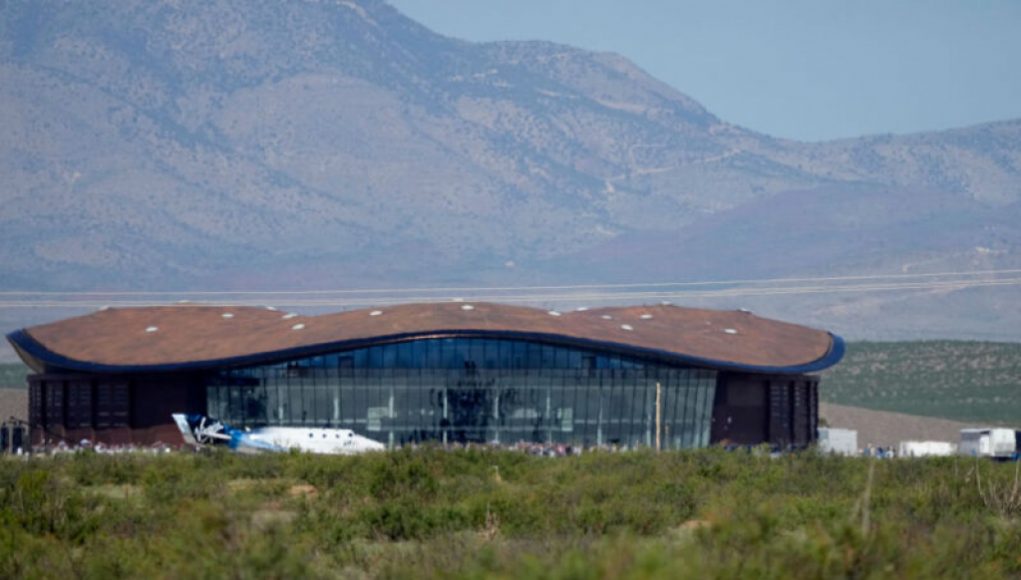SPACEPORT AMERICA, New Mexico—I’m standing on a spaceport runway at the ass end of nowhere. The sun has started to creep over the craggy San Andreas Mountains, illuminating the massive, alien spaceship-like building here in New Mexico that Virgin Galactic calls home.
I have traveled all this way in early August to find a little illumination of my own. In particular, I want to know just what the heck Virgin Galactic is up to. Founded by Sir Richard Branson some 19 years ago, the company has had a wild ride in its quest to become the world’s first bona fide space tourism business. Along the way, Virgin Galactic’s stock soared as high as $56 a share, then crashed to now barely above $3. One of its spaceships crashed, too, nearly nine years ago, killing a test pilot. But now it’s moving forward in a positive direction.
Later on Thursday morning, with a stunning rocket blast initiated about 14 km above the New Mexico desert, the company completed its seventh flight to an altitude of 88 km, above the vast majority of Earth’s atmosphere. Most of the previous missions were test flights to push the envelope of the VSS Unity spacecraft’s capabilities. Thursday’s flight, dubbed Galactic 02, was actually the first time the company flew a private astronaut into space—and this is the reason Virgin Galactic exists, after all.
Advertisement
More than 1,000 people have bought tickets for the Virgin Galactic experience, which includes a few minutes of weightlessness after a one-minute rocket ride to the top of the world. The first several hundred paid $250,000 for their tickets more than 15 years ago, with the expectation of starting flights around 2010. One of them was on board the space plane Thursday.
This was Jon Goodwin, a British businessman who recently turned 80 years old. Goodwin purchased his ticket all the way back in 2005. He was just the fourth person to do so. But he has Parkinson’s’ disease and is running out of time. He knows it.
“The fact that I am now able to do this is completely magical,” he said. “Defying Parkinson’s is hopefully inspirational.”
He was joined on the flight by Keisha Schahaff and Anastatia Mayers, a Caribbean mother-daughter duo whose tickets were purchased by the nonprofit Space for Humanity in order to broaden access to space. So with this single mission, Virgin Galactic really did, at long last, start to fulfill its goals of broadening access to space.
It was a moment. But will it be a fleeting moment? What does Thursday’s successful flight actually mean? Does Virgin Galactic have a successful future? I came to New Mexico to find out.
Virgin Galactic, the world’s leading space tourism provider, recently launched its first successful crewed space flight on December 13, 2020, over the skies of Southern California. This milestone brings the future of space exploration and commercialized space travel closer to becoming a reality. With the success of this launch, many eyes have turned to Virgin Galactic and the question remains – is the company on a path to success?
Since its inception in 2004, Virgin Galactic has been working to revolutionize the space industry and make commercial space travel for civilians a reality. Although the November of 2019 setback, in which pilot Michael Alsbury lost his life, has cast a shadow over the organization, the successful mission on December 13 now presents a glimmer of hope that commercial space travel may achieve its goal and ultimately be a viable option.
Not only was the launch a major milestone for the company, but it also brought to light the revolutionary technology and design that Virgin Galactic has been developing since its inception. The launch, using the VSS Unity spacecraft, was powered by hybrid rocket motor technology and it enabled the spacecraft to climb to an altitude of 51.4 miles before descending to a safe landing in the Mojave Desert.
The success of the launch marks an important demonstration of the company’s operational capabilities and helps to solidify their commitment to safety and reliability. As the company moves forward, it continues to develop cutting-edge technologies that will expand the opportunities available to space travelers.
These innovative technologies, paired with experienced Virgin Galactic staff, offer a level of confidence that commercial spaceflight is on the path to success. Additionally, the upcoming Space Act Agreement with NASA paves the way for further exploration beyond the boundaries of Earth.
Virgin Galactic has come a long way since its initial conception and its successful launch of VSS Unity marks a new era for space exploration and the possibilities of commercial space travel. With the right steps, thecompany is on a path to becoming a leader in space exploration, and the possibilities of the journey ahead will be truly exciting.




















